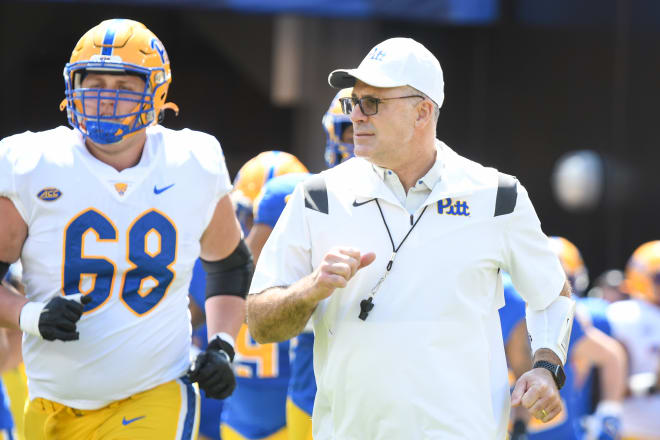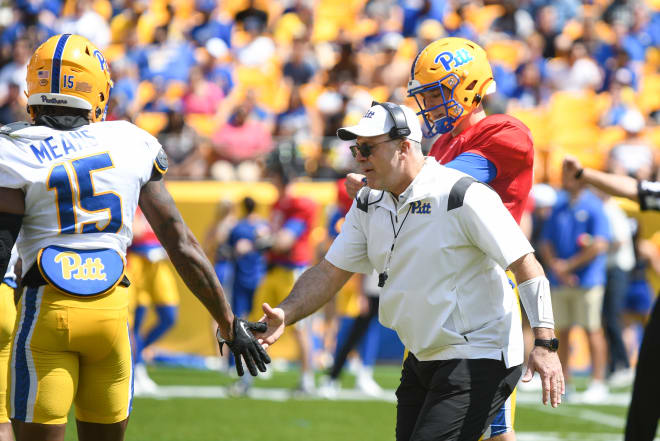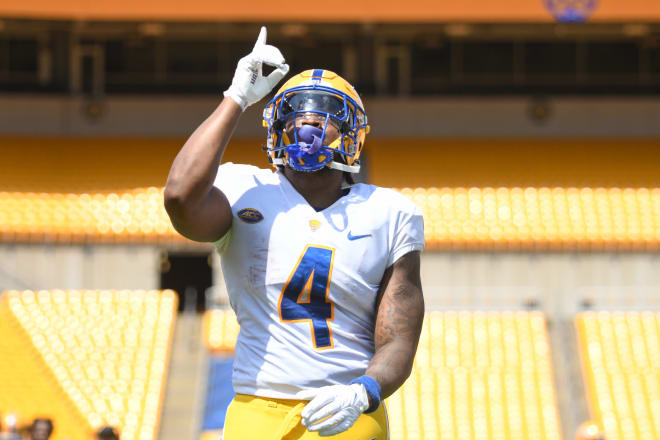The 3-2-1 Column: The Draft, transfers, a commit, linebackers and more
In this week's 3-2-1 Column, we're thinking about the NFL Draft, Pitt's (lack of) transfers, a new commitment and more.

THREE THINGS WE KNOW
The Draft that was
I can’t say there were too many surprises in the 2023 NFL Draft from a Pitt perspective.
Calijah Kancey went in the first round, like we all expected (even if there was some late noise from the draft experts that he might not hear his name called on Thursday night).
Pitt’s other five Draft picks were pretty much what we expected, too, at least in terms of the names. I figured Carter Warren, Israel Abanikanda, SirVocea Dennis and Brandon Hill would get drafted, too. I had Habakkuk Baldonado as the projected sixth pick from Pitt; it ended up being Erick Hallett instead (who was actually the fifth Panther selected).
Either way, I thought six Pitt players would hear their names called over the weekend, and that’s how it turned out.
By now, you’ve no doubt seen the benchmarks. Pitt tied for the most picks from an ACC school in this year’s Draft and the fifth-most selections of any school in the country. And no team in the conference can top the 14 Draft picks Pitt has produced in the last three years.
That’s pretty impressive, and the Panthers’ 26-12 record and ACC championship in that span is, in no small way, tied to that level of talent.
Now, after eight seasons at Pitt, Pat Narduzzi has had nearly 30 players drafted. 25, to be exact, although that’s the number of players who played under Narduzzi and were drafted directly from Pitt to the NFL. I am of the opinion we can add both Ben DiNucci and Jordan Addison in the total; Narduzzi and his staff recruited them to Pitt, signed them at Pitt and played them at Pitt. They should get at least some credit for that success.
If we do that, it bumps the number to 27, which isn’t too shabby.
Unsurprisingly, the numbers are strongest at defensive back. With Hallett and Hill going in the 2023 Draft, Pitt has now had eight DB’s drafted under Narduzzi, with seven of those being recruits he signed (Avonte Maddox is the lone exception). Plus, things are trending up in that department with five of those eight defensive backs being taken in the last three drafts (and probably a couple more coming in the next few drafts).
It’s been a good run, and while I don’t necessarily think there will be six Pitt players selected in next year’s Draft, I think there will be a few, and I expect the trend to continue.
As far as this year’s Draft, I’m excited to see what Kancey does in the NFL. Size has always been the question, but he’s so explosive and so quick that he should be able to make up for anything he gives up size-wise.
Israel Abanikanda should have a good chance to contribute with the Jets. Breece Hall is one of the top young running backs in the NFL, but Abanikanda will have a chance to get ahead of fellow ACC product Michael Carter, and I won’t be surprised if we see some long-run highlights from Abanikanda sprinkled throughout the season. Speed is his biggest weapon, and I think he’ll get a chance to use it.
I think Brandon Hill can surprise in Houston. He was my sleeper pick heading into the Draft, and I was surprised he lasted until the seventh round. He’s a little on the shorter side, but he’s put together pretty well, he’s really fast and he’s a physical player (you have to be in order to play the boundary safety position in Pitt’s defense).
Hill might end up being one of the steals of the 2023 Draft.
Whatever happens, it was a good weekend for Pitt.

The Kedon-Phil connection
Someone mentioned to me this week that there doesn’t seem to be nearly as much enthusiasm for Pitt’s quarterback situation right now as there was a year ago at this time, and the more I thought about it, the more I agreed with the premise.
I don’t recall the exact posts last year, but I do believe there was more optimism about Kedon Slovis than there is for Phil Jurkovec. And as I continued considering the comparison, I came to the conclusion that there just might be a connection between the two.
Last year at this time, I think there was a fair amount of optimism regarding Slovis based on what he did at USC. After all, he left the Trojans as the Pac-12’s all-time leader in career completion percentage and led the conference in pass attempts, pass completions, passing yards, passing touchdowns and fewest interceptions in 2020.
That was really encouraging. I know because I repeated all of those stats a lot of times. I repeated his stats from 2019, too, when he was second in the conference in passing yards, third in passing touchdowns and second in pass efficiency to earn Pac-12 Offensive Freshman of the Year honors.
That was all very encouraging. And while his 2021 season was a drop from the previous two, Pitt was certainly bound for success if he could recapture his earlier form.
He didn’t, of course, and Pitt’s two worst losses of the season fell squarely on the shoulders of the offense and, by extension, Slovis.
Fast forward to the 2023 offseason, and Pitt is headed for a season where the offense will rely on a veteran quarterback who arrived as a transfer looking to bounce back from some mediocre years to recapture the success he enjoyed early in his career.
Slovis and Jurkovec aren’t mirror images of each other in terms of their resumes, but that sounds familiar enough to make a Pitt fan shudder.
Like Slovis, Jurkovec’s best year was 2020 (maybe these guys are just good in pandemic-shortened schedules). That year, the former Pine-Richland four-star completed 61% of his passes for 2,558 yards, 17 touchdowns and five interceptions in 10 games.
In an ACC that featured Trevor Lawrence, Kenny Pickett and Sam Howell as well as early versions of guys like Malik Cunningham, Hendon Hooker, Jordan Travis, Devin Leary and Sam Hartman, among others, Jurkovec ranked fifth in pass completions, sixth in passing yards and sixth in passing touchdowns while tying Lawrence for second in fewest interceptions among starting quarterbacks (Notre Dame’s Ian Book threw three that year).
With the caliber of quarterbacks in the league, Jurkovec didn’t get any all-conference recognition, but he had a certifiably good season.
The next two years were…not as good. Saddled by injuries and inconsistent offensive line play, Jurkovec was worse in almost every way. He completed just 58% of his passes in that span and threw 18 touchdowns against 12 interceptions.
It was bad enough that “Look at the quarterback play he had to overcome” became a rallying cry for the draft pedigree of Boston College receiver Zay Flowers (never mind that nearly half the passes thrown in 2022 came from second-year player Emmett Morehead and Jurkovec threw just 96 passes in 2021, compared to 192 for Dennis Grosel and another 16 for Morehead).
Anyway, the situations aren’t perfect analogues, but there’s enough similarity between Slovis and Jurkovec that I think it has to be giving some Pitt fans pause. Last season, they were counting on a transfer quarterback to return to form and it didn’t work; now they’re staring down the same kind of expectation, and there might be a bit of trepidation.
I also wonder if some Pitt fans, having seen Jurkovec spurn the Panthers twice, spent the last five years convincing themselves that he wasn’t good, which can get kind of tricky when those same fans are now going to be counting on him to lead the team.
Or maybe it just comes down to watching Jurkovec the last two seasons and not being very impressed.
Either way, I don’t sense a lot of excitement about the quarterback situation right now.

The transfers out Typically in these columns, I set a goal of roughly 500 words or so for each section. Sometimes it’s more, sometimes it’s less, but that’s the general target.
So if I was going to write a section on the transfers Pitt has lost since the end of spring camp, I would have about 495 words to fill, because here’s the extent of it:
Myles Alston Sam Vander Haar
(I appreciate that Vander and Haar are separated; that will give me an extra word every time I type it.)
Word counts aside, I think you can guess where I’m going with this section of the column. Pitt has lost just two players to the transfer portal since the end of spring camp, and that seems pretty impressive to me. We often hear people say - and we ourselves often say - “Let’s see what happens after spring camp” with regards to transfers, and it makes sense. Players go through spring camp and emerge with a rather clear picture of where they stand on the depth chart and, by extension, a rather clear picture of what kind of playing time they can expect in the fall.
Then they decide to stick it out or leave. For players who don’t see a clear path to the field, the decision is made to go. And I think that’s totally understandable: you came to college to play football, and if you don’t think you’re going to get an opportunity to do that, whether it’s because of the talent ahead of you or the impression you get from the coaches, you should go somewhere that can give you that opportunity.
For Pitt, there were two players who made that call after spring camp:
Alston and Vander Haar.
Both guys make sense, to varying degrees. Vander Haar went from being Pitt’s No. 1 punter as a freshman a year ago to definitively outside the top two (Caleb Junko and Elon transfer Jeff Yurk were both announced by Pat Narduzzi and Andre Powell as being the main competitors for the job).
So Vander Haar understandably went looking for a new home, which opened a scholarship that will likely go to one of those other punters.
Alston is a little more surprising, but not too much. He was probably headed for a second-team role and could have been a serviceable backup, but there were a few things for him to consider. First, there’s the looming possibility that Pitt will add another transfer receiver (the coaches certainly want to). That would likely drop Alston on the depth chart even further, which he probably wouldn’t have appreciated.
Second, and perhaps most importantly, maybe he just wanted a chance to be a first-team player. That’s not unreasonable, and he picked a school in Old Dominion that might be able to offer it to him.
So we wish Vander Haar and Alston the best of luck. Their decisions to leave made sense, and I don’t think there are any hard feelings about their departures.
But what’s most interesting to me is that Vander Haar and Alston are the only post-spring transfers Pitt lost. Surely, there have to be other third or fourth-year players who looked at the two-deep in the spring and realized they weren’t on it. Surely, those guys have to have considered looking for a new opportunity at a school where they could be higher on the depth chart. And surely, no one would have blamed them for going.
But no, Shirley, they did not go. Nobody else did.
Just Vander Haar and Alston. That’s a pretty low number - and I think it’s pretty impressive.

TWO QUESTIONS WE HAVE
Do we value player retention enough?
I’m carrying the last topic over to this section of the column.
(Remember my target of 500 words for each section? I’ve got that last section at 597 words, so it’s time to break to a new section, even if the topic is continuing.)
In the world of the transfer portal, where everyone’s talking about who’s going in and who’s going where, we frame everything in terms of losses and gains.
Which players did you lose and which players did you gain?
But there’s a middle ground in there, a space between losing players to the portal and gaining players from it.
It’s player retention.
Holding onto your own players.
To me, now more than ever, that seems pretty important, but we don’t seem to give teams much credit for it.
At least, we don’t talk about it much. All the transfer-focused Twitter accounts and landing pages and hyper-attention paid to the portal center around the transactions: the ins and the outs, the comings and goings, the attrition and the addition.
But what about the retention? Can we get a little love for the teams that hold onto their players? The teams that make it through an offseason without losing any starters or key role-players?
I guess it’s tough because you can’t really rank retention. You can’t make a list of the teams that did the best in retention. You won’t get much in the way of social media metrics if you put out a bunch of tweets about the job this coaching staff or that coaching staff did in holding its roster together.
But it’s really important, and I think coaches get that. I think coaches look around the country and notice who retained their players and who didn’t. And I think most coaches would tell you that the programs they respect the most in this era of college football are the ones that hold onto their rosters.
It’s an undervalued trait, but it’s one that will become more notable, I think, over the next few years.
So far, Pitt has been pretty good at it. I think there’s a few reasons for that.
One is the standard response of “culture,” whatever that means. Locker room, chemistry, honesty, trust, respect, good times, great fun - however you want to term it. I think Pitt does have a “culture,” which I admit is a rather nebulous term but one that has come to be understood in sports as a program or organization that generally has good vibes inside the walls. Everybody mostly gets along, everybody mostly respects each other and everybody mostly enjoys working together.
You’re not going to keep everyone happy all the time; that’s just not possible when you’re dealing with 100+ young men. Sometimes guys will get disgruntled or frustrated or unhappy with the situation. It happens.
But if you have a good culture, those guys will be the minority.
The other element that I think helps is stability. I know it gets mocked from time to time (“A lot of good stability did when Pitt played against a team that fired its coach six days earlier hardy har har!”) but there is still value in it. There’s value in having continuity at most coaching staff positions: the players know what to expect and they know what is expected. I think that can go a long way in making it appealing for guys to stay home.
You’re always going to need to add through the portal. But keeping your own players from going into the portal is an important part of the equation, too.

Which departure hurts the most?
Continuing the topic of transfers, let’s talk about the 12 guys who left this offseason. Here’s the list (and where they went):
QB Kedon Slovis (BYU)
RB Vincent Davis (UNLV)
WR Jaden Bradley (Charlotte)
WR Jaylon Barden (Georgia Southern)
WR Myles Alston (Old Dominion)
WR Gavin Thomson (UNLV)
TE Kyi Wright (James Madison)
DE John Morgan (Arkansas)
DE Sam Williams (Murray State)
DB Khalil Anderson (East Tennessee)
DB Judson Tallandier (Akron)
P Sam Vander Haar (undecided)
I have to think that the first thing to jump out from that list is the remarkable lack of starters. Slovis and Morgan were starters in 2022, but the other 10 were not.
That’s not too much of a change from last year, when Pitt lost three starters to the portal - receiver Jordan Addison and linebackers Wendell Davis and Cam Bright - so the trend is certainly one of the Panthers not seeing too many top-line players take off.
It also makes it somewhat difficult to rank the guys whose departures hurt the most. Who is Pitt going to miss the most in 2023? That’s tough to say. There’s no obvious option like Addison, and even Davis and Bright would have had big roles for Pitt in 2022. I’m not sure you can say that about anybody Pitt lost this offseason.
If I had to pick one, it might be Jaden Bradley. He left the team at midseason last year under rather curious circumstances - which is always the case when a player leaves a team at midseason - and the situation was probably untenable at that point.
So picking Bradley as the transfer they’ll miss the most comes with the caveat of Bradley and the Pitt staff finding some common ground and resolving their differences.
I don’t know if that was possible, but if it could have happened, Bradley’s size and talent could have been a useful addition to this year’s receiving corps (the shortcomings of which we’ve discussed plenty of times).
Beyond that, I think you’re mostly looking at players who could have helped as veteran reserves.
John Morgan would potentially be in a backup role on this year’s roster. Ditto for Vincent Davis, Kyi Wright, Khalil Anderson and Judson Tallandier. And there’s value in those roles: having older players to work down the depth chart is a good thing. Even Kedon Slovis could have a useful role on this team - either by pushing Phil Jurkovec or providing the offense with a backup quarterback who has thrown more than 1,200 passes in college.
My point is this:
Pitt didn’t lose a whole lot to the portal this offseason. We talked about that in terms of numbers earlier in this column, but I think it’s not just a matter of quantity; it’s quality, too. I don’t mean to kick dirt on guys who left town, but I believe it’s the truth.

ONE PREDICTION
Linebackers will keep trending up
Pitt added a new commitment yesterday when Red Bank Catholic (NJ) three-star Davin Brewton made it public for the Panthers.
I like the addition of Brewton. He’s a 6’1” 225-pound middle linebacker who has been compared to SirVocea Dennis by the Pitt coaches. Brewton is certainly productive, having made more than 200 tackles over the last two seasons while leading Red Bank Catholic to a 21-3 record and back-to-back state title appearances. I think he’ll be a nice fit in Pitt’s defense when he arrives in 2024.
But there’s something else I’m interested in here - more of a big-picture topic.
It’s the linebacker position overall.
I really think the position has been trending up. SirVocea Dennis was drafted this year, making him the first Pitt linebacker to be taken in the NFL Draft since 2009 when Scott McKillop was selected in the fifth round. Bangally Kamara should be drafted next year, and if Solomon DeShields doesn’t have a breakout season in 2023 and follow Kamara to the 2024 Draft, I think he’ll be there in 2025.
And I think the recruiting has been trending in the right direction. Look at the classes of linebackers Pat Narduzzi has signed since his first full class in 2016.
2016 - Chase Pine, Kaezon Pugh, Elias Reynolds
2017 - Cam Bright, Kyle Nunn, Albert Tucker
2018 - Wendell Davis
2019 - SirVocea Dennis, Brandon George, Leslie Smith
2020 - Solomon DeShields, Bangally Kamara, AJ Roberts
2021 - Preston Lavant
2022 - Kyle Louis, Marquan Pope
2023 - Jordan Bass, Rasheem Biles, Braylan Lovelace
Not every player in the last four classes has been a hit (we haven’t even seen the guys from the 2023 class in a game yet), but when you compare the first four classes to the last four, it favors the latter, I think.
The classes of 2016-19 produced three starters (Cam Bright, Wendell Davis and SirVocea Dennis) and two good backups (Chase Pine and Brandon George) out of 10 total recruits.
The classes of 2020-23 have produced projected starters for this season in Kamara and DeShields, and I’ve heard a lot of good things about Kyle Louis and his potential. Then the class of incoming freshmen features arguably the top commit in the class in Jordan Bass, a really intriguing athletic outside linebacker in Rasheem Biles and a surprise breakout candidate from Leechburg in Braylan Lovelace, who earned some really high praise from the coaches this spring.
The group might be a little thin on experienced depth this season, with Kamara, DeShields, 2022 Notre Dame transfer Shayne Simon and George as the only linebackers who have played. And they could be relying on a lot of youth in 2024, too, if Kamara, Simon and possibly DeShields all leave for the NFL.
But the overall linebacker room looks more talented than it has in some time.
